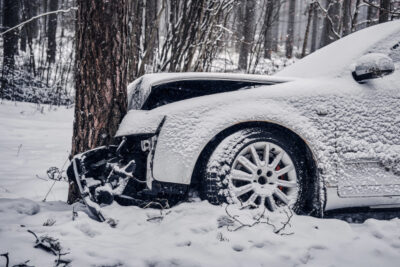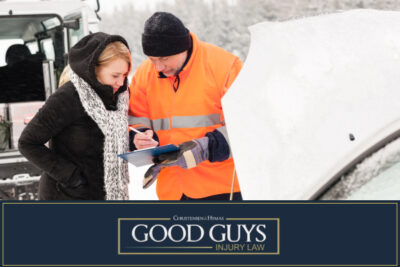
Winter car accidents are frequent during the colder months; recent traffic studies report a significant increase in collision rates during this season. Snow and ice create dangerous road conditions, making it harder to control your vehicle.
During these winter months, drivers face reduced visibility and slippery roads, which increase the chances of an auto accident.
Knowing the causes and consequences of winter accidents and what steps to take afterward can help protect your rights and improve your chances of receiving fair compensation.
At Good Guys Injury Law, we help victims of winter accidents get through these challenging situations. Our team provides expert guidance to help manage insurance claims and handle the legal side.
Table of Contents
Common Causes of Car Accidents in Snow
Harsh weather conditions often cause winter car accidents. Ensuring safety remains the top priority when driving in winter conditions. A few common causes of winter car accidents that we see include:
Reduced Visibility Due to Snowfall and Icy Conditions
Winter weather conditions, such as icy roads and heavy snowfall, make it harder to see clearly. Inclement weather can obscure road signs, other vehicles, and even pedestrians.
Icy roads add to the danger, making stopping or maneuvering difficult, especially in winter accidents. Reduced visibility also increases the likelihood of rear-end collisions and other crashes.
Slippery Roads and Loss of Vehicle Control
Winter accidents often occur because of slippery roads. Icy roads reduce tire traction, leading to the loss of vehicle control. Drivers may skid or spin out when driving too fast, even in light snow or ice. The risk of accidents increases, especially when roads are untreated, or temperatures fluctuate, causing black ice.
Driving Too Fast in the Snow
Driving too fast in heavy snow can be dangerous. Winter accidents occur when drivers don’t adjust their speed to match snowy or icy road conditions. Snow and ice make brake quickly or turn difficult without losing control. Driving below the speed limit is often necessary in winter to avoid accidents and maintain safety.
Maintaining a safe distance between vehicles is critical during winter conditions. According to Utah Code Ann. § 41-6a-804, drivers must maintain a safe stopping distance, particularly in icy or snowy conditions where stopping distances can increase dramatically.
Sometimes, drivers fail to adjust their speed, which leads to accidents in these winter conditions. Under Utah Code Ann. § 41-6a-601, drivers must adjust their speed to match road conditions, such as snow or ice.
Drivers must not drive at speeds greater than safe, given the current road and weather conditions, regardless of the posted speed limit.
Lack of Proper Driving Equipment for Winter Conditions
Winter car accidents can also result from drivers not preparing their vehicles for winter conditions. Without snow tires, proper windshield wipers, or strong brakes, drivers are more likely to face accidents.
Icy pavement requires winter tires for better traction, while ineffective lamps or windshield wipers can reduce visibility, increasing accident risks. Ensuring the vehicle is winter-ready can help reduce risks. Adding a fuel stabilizer to the gas tank may also improve vehicle performance in low temperatures.
Even small adjustments in driving style can significantly enhance safety on winter roads. Drivers should also ensure their vehicle’s battery is in good condition, as cold weather can drain it faster.
Low tire pressure, often in winter, reduces traction and increases accident risk. Using improper antifreeze or neglecting de-icing solutions for windows can limit visibility, making accidents more likely. Improper vehicle maintenance for winter conditions can also contribute to accidents.
Proper winter preparation goes beyond tires and wipers, encompassing all aspects of vehicle maintenance. These extra precautions can significantly lower the chances of dangerous winter driving incidents.
Types of Expenses You Might Incur After a Snow-Related Car Accident

Winter car accidents often lead to various expenses, including medical bills and vehicle repairs. Icy pavement can cause major collisions, leaving victims with severe injuries or totaled cars. Besides physical damage, accident victims may lose income if they can’t work due to their injuries.
You might also face additional costs like towing fees or rental cars during repairs. These expenses can add up quickly after a snow-related accident.
- Medical bills for injury treatment
- Car repairs or replacement costs
- Lost wages due to missed work
- Costs of renting a vehicle
- Legal fees for handling claims
What Should You Do After a Snowy Car Accident in Utah?
If you’re in a winter car accident, take immediate action. First, check for injuries and call for medical help if needed. Report the accident to the police, especially on icy roads or in bad weather cases.
Document the scene by taking pictures of the snow and road conditions. This helps in filing insurance claims later. It’s also vital to exchange information with other drivers involved. Lastly, contact your insurance company to start the claims process.
Determining Fault in Snow-Related Accidents

Determining fault in snow-related auto accidents can be complicated. Drivers are still expected to adjust their driving to the snowy conditions. If someone drives too fast or ignores the dangerous weather, they may be found at fault for the accident. However, poor road conditions or unexpected weather changes can also affect crashes.
How Driving Too Fast for Conditions Can Establish Fault
Driving too fast in snowy and icy conditions can often cause a fault in an accident. Even if the speed limit is followed, going too fast for the weather can lead to accidents.
Snow and ice require slower driving, and failure to adjust speed can result in losing control. Courts may determine that speeding in unsafe conditions is negligent behavior contributing to fault.
Role of Weather Conditions vs. Driver Negligence
Snowy weather alone doesn’t automatically place blame for accidents. Courts often weigh weather conditions against driver negligence to assign fault. A driver may not be fully responsible if extreme winter weather causes the crash.
However, if the driver was reckless or failed to take proper precautions, they may still be found negligent.
Using Accident Reconstruction Experts to Prove Liability
Accident reconstruction experts can be key in determining fault in winter automobile accidents. These experts use data like skid marks, vehicle damage, and road conditions to analyze what caused the accident. They can provide insights into whether the crash was due to weather conditions or driver error. This evidence can help in proving liability in complicated cases.
How a Lawyer Can Help After a Snow-Related Car Accident

Hiring a lawyer after a winter car accident can make a major difference. They can help you gather evidence, negotiate with your insurance company, and make sure you receive fair compensation. Lawyers can also assist with medical bills and other expenses that arise from the accident.
If the insurance company tries to offer a low settlement, a lawyer will advocate for your rights. Winter car accidents often involve multiple factors, such as icy roads and driver negligence, which your lawyer will go through.
Call Our Utah Car Accident Lawyer for a Free Consultation

If you’ve been in a winter car accident, our law firm can help. At Good Guys Injury Law, we have experience handling complex winter accident cases. We can evaluate your case, work with your insurance company, and help you recover compensation.
Winter accidents can be challenging due to the icy roads and harsh weather conditions. Our experienced lawyers will fight to ensure your rights are protected.
Contact us today for a free consultation to discuss your case and get the help you deserve.






